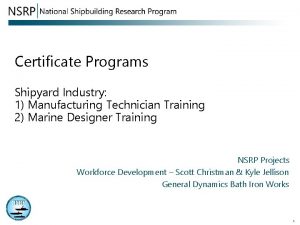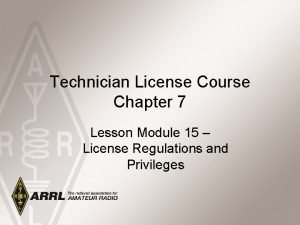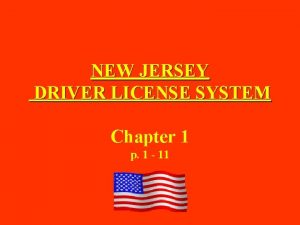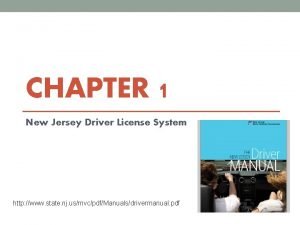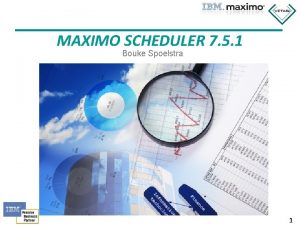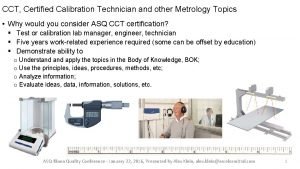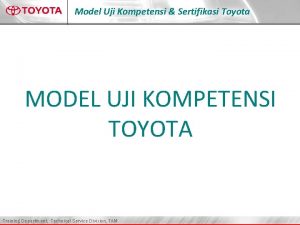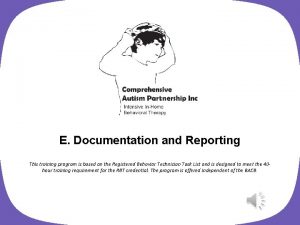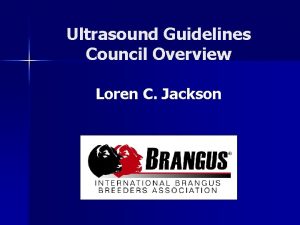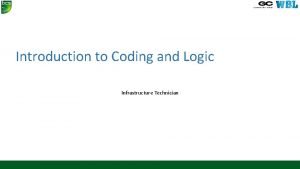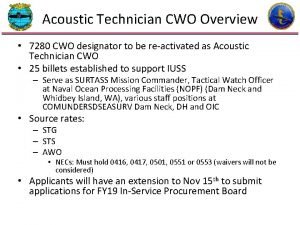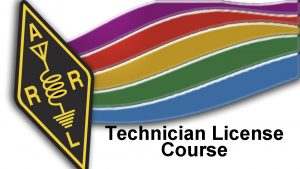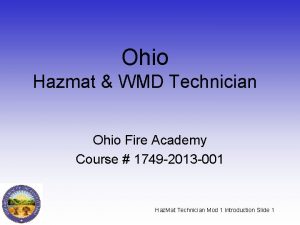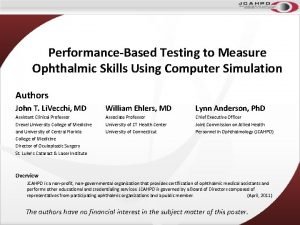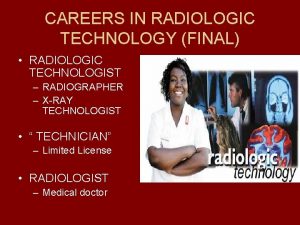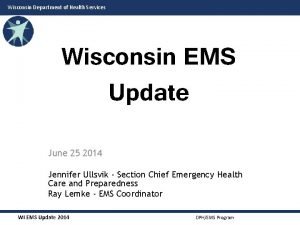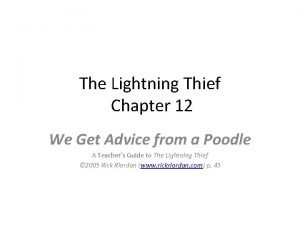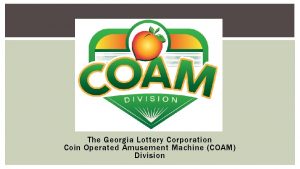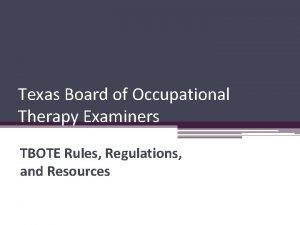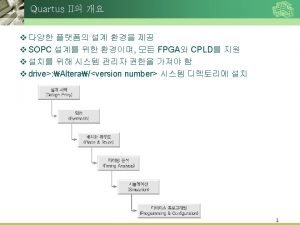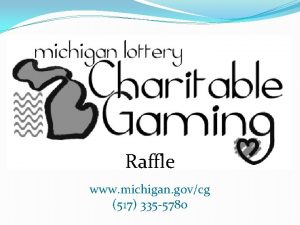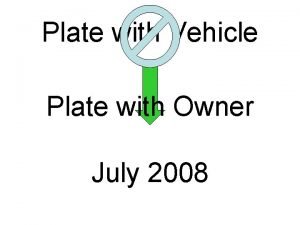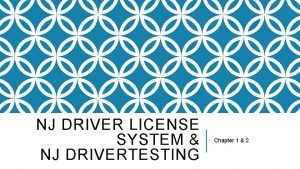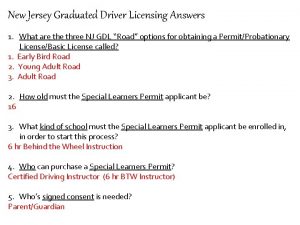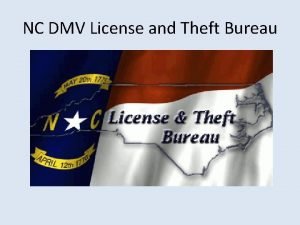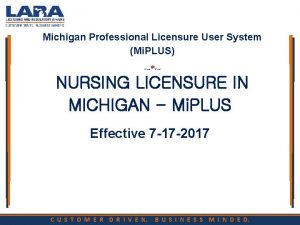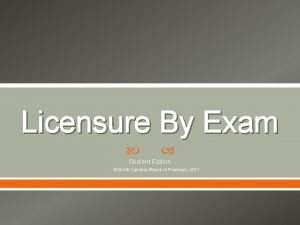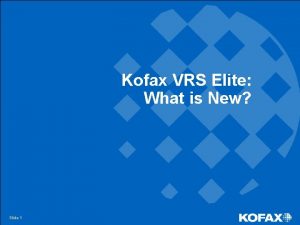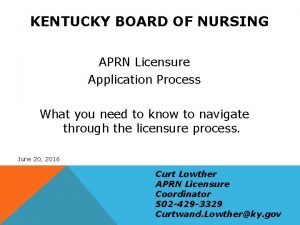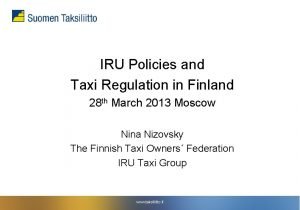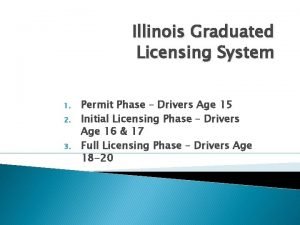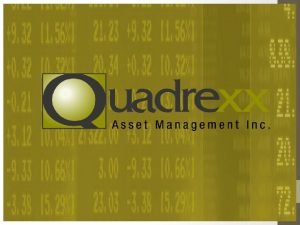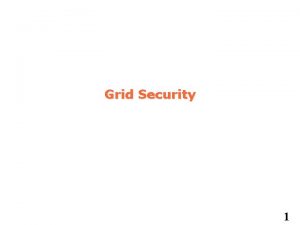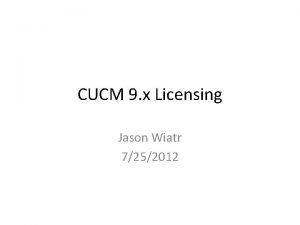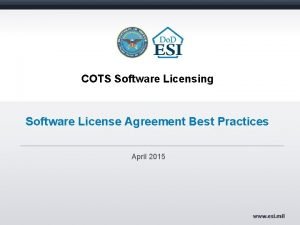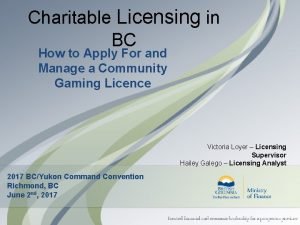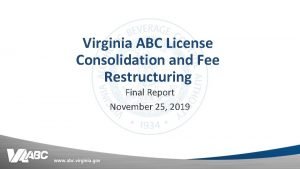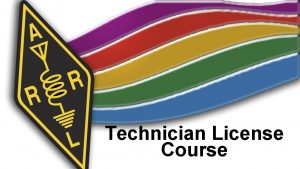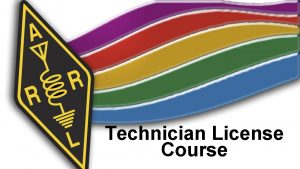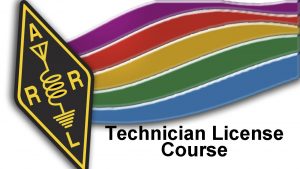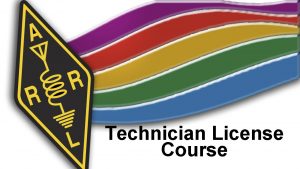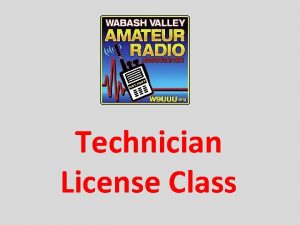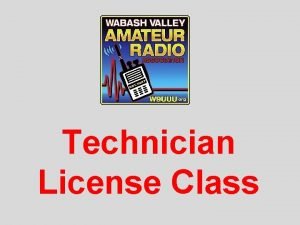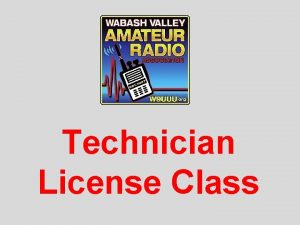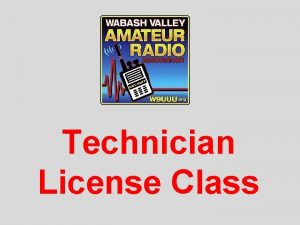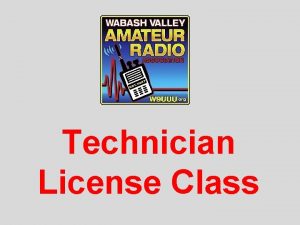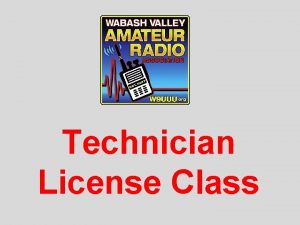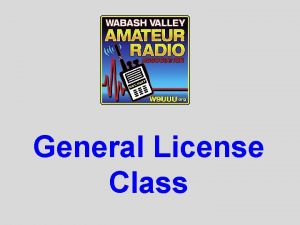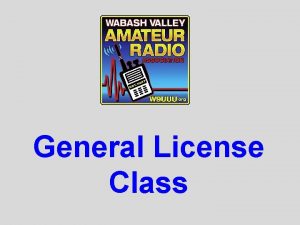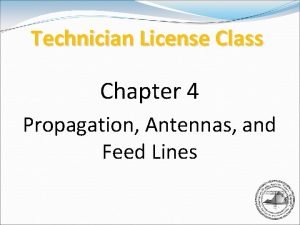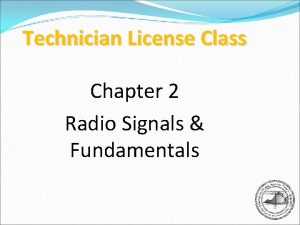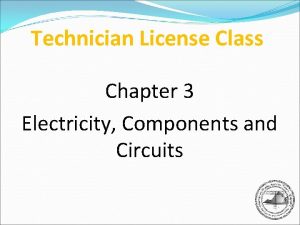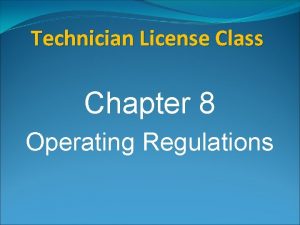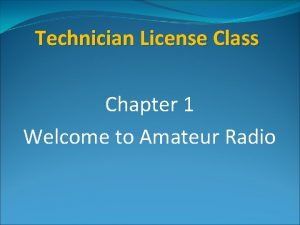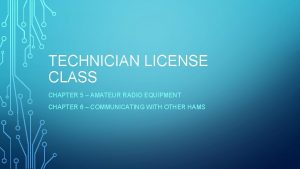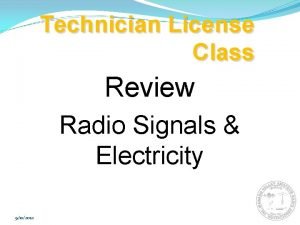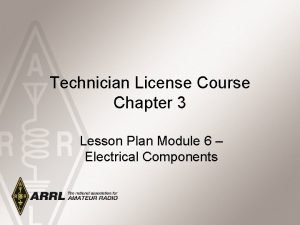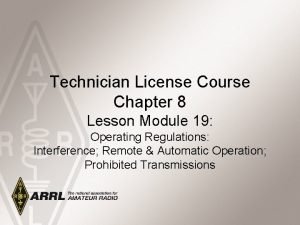Technician License Class Technician Class Chapter 1 Introduction














































































- Slides: 78

Technician License Class

Technician Class Chapter 1 Introduction

What is Amateur Radio? Section 1. 1 contains a lot of interesting background & introductory material. • Read it at your leisure. • Not covered in class. • No questions over this material.

The FCC and Licensing Why Get a License? • Unlike other radio services, the amateur can select between many different types of operating activities. • Operating without a license is a violation of federal law, leading to large fines & possibly jail time. • License provides protection from interference from unlicensed operations.

The FCC and Licensing Overview. • FCC has different rules for different types of radio usage. • Each type of usage is referred to as a “Service”.

The FCC and Licensing Overview. • Most services do not require an examination. • Limited number of frequencies. • Limited purposes of operation. • Equipment must be approved by the FCC.

The FCC and Licensing Overview. • Amateur Radio Service. • Wide Range of frequencies across entire RF spectrum. • Many types of operation. • Equipment may be purchased off the shelf or may be home-built.

The FCC and Licensing Overview. • Amateur radio licenses. • 3 classes of licenses currently being issued. • Technician. • General. • Amateur Extra.

The FCC and Licensing Overview. • Amateur radio licenses. • 2 classes of licenses not currently being issued but which can be renewed. • Novice. • Advanced.

The FCC and Licensing Overview. • Amateur radio license exams. • Examinations were originally administered by the FCC. • Many had to travel long distances to take exam. • Had to wait several weeks to get license.

The FCC and Licensing Overview. • Amateur radio license exams. • Examinations are now administered by volunteers under the auspices of a Volunteer Examiner Coordinator (VEC). • Examination sessions held locally. • New license issued quickly. • Upgraded license new privileges are available immediately.

The FCC and Licensing Overview. • Amateur radio license exams. • Element 2 – Technician Exam. • 35 questions. • Element 3 – General Exam. • 35 questions. • Element 4 – Amateur Extra Exam. • 50 questions.

The FCC and Licensing Overview. • Amateur radio license exams. • Technician class license. • Must pass element 2. • Element 3 – General class license. • Must pass elements 2 & 3. • Element 4 – Amateur Extra class license. • Must pass elements 2, 3, & 4.

Amateur Radio Activities Identification and Contacts. • A call sign is used to identify your transmissions. • Call signs are unique. • No 2 amateur radio operators in the world have the same call sign. • Your call sign becomes your “on-air” identity.

Amateur Radio Activities Identification and Contacts. • In the USA, a call sign might indicate what part of the country an amateur lives in.

Amateur Radio Activities Identification and Contacts. • In the USA, a call sign might indicate the class of operator license held. Group Definition Class 1 x 2 (1 st letter K, N, or W) 2 x 1 (1 st two letters AA-AL) 2 x 1 (1 st letter K, N, or W) 2 x 2 (1 st two letters AA-AL) Amateur Extra A, B, C, or D B A Groups Advanced B, C, or D General C or D 2 x 2 (1 st letter K, N, or W) Technician C or D C 1 x 3 (1 st letter K, N, or W) Novice D D 2 x 3 (1 st letter K or W)

Amateur Radio Activities Identification and Contacts. • Any conversation with another amateur radio station is called a “contact”. • An attempt to make a contact is called a “call” or “calling”.

Amateur Radio Activities Identification and Contacts. • There are 4 main types of contacts: • • Voice contacts. Morse code contacts. Digital contacts. Image contacts. • Fast-Scan TV (ATV). • Slow-Scan TV(SSTV).

Amateur Radio Activities Emergencies and Public Service. • Amateur radio operators have a long tradition of public service communications. • Emergencies. • Message handling. • Public service events.

Amateur Radio Activities Emergencies and Public Service. • • • ARES. RACES. SATERN. HWN. SKYWARN.

Amateur Radio Activities Awards and Contests. • Many amateur operators work to win awards for certain operating achievements: • WAS, DXCC, etc. • Many try to win trophies or certificates by participating in contests.

Amateur Radio Activities Novel Activities. • • • SSTV and ATV. Packet Radio and Broadband Hamnet. APRS. Meteor Scatter and EME. Satellites.

Getting Your Ham Radio License The Technician License. • Entry-level license. • A little over 50% of all US amateurs hold a Technician class license. • 385, 181 out of 760, 054 as of August 31, 2019. • Primarily local area communications.

Getting Your Ham Radio License Obtaining a License. • Study The Ham Radio License Manual or other materials. • Take the exam. • Receive a CSCE. • Can operate when call sign issued. • For Laurel VEC normally next business day.

Getting Your Ham Radio License What We Assume About You. • Strong interest in Amateur Radio. • Basic math. • Learn new words and terminology.

Getting Your Ham Radio License Online Practice Exams. • • http: //arrl. org/tech-prep-resource-library http: //aa 9 pw. com/radio/technician http: //eham. net/exams https: //www. qrz. com/hamtest

Getting Your Ham Radio License Testing Process. • Test sessions are coordinated by a Volunteer Examiner Coordinator (VEC). • FCC recognizes 14 VECs. • Individual VEC’s may or may not charge a test fee. • ARRL = $15 • W 5 YI = $14 • Laurel VEC = No test fee • Team of at least 3 Volunteer Examiners (VEs) required to administer exam.

Getting Your Ham Radio License Testing Process. • Exam session for this class: • Last class session. • Bring to session: • • Photo ID. FRN. Pen (for signing paperwork). Pencil (for filling out answer sheet). • No test fee.

Technician Class Chapter 2 Radio and Signals Fundamentals

Metric Units. • Most of the time we will be using metric units. • Need to be familiar with several of the metric prefixes & how to convert between them.

Metric Units

T 5 B 01 -- How many milliamperes is 1. 5 amperes? A. B. C. D. 15 milliamperes 1500 milliamperes 15, 000 milliamperes

T 5 B 02 -- What is another way to specify a radio signal frequency of 1, 500, 000 hertz? A. B. C. D. 1500 k. Hz 1500 MHz 15 GHz 150 k. Hz

T 5 B 03 -- How many volts are equal to one kilovolt? A. B. C. D. One one-thousandth of a volt One hundred volts One thousand volts One million volts

T 5 B 04 -- How many volts are equal to one microvolt? A. B. C. D. One one-millionth of a volt One million volts One thousand kilovolts One one-thousandth of a volt

T 5 B 05 -- Which of the following is equal to 500 milliwatts? A. B. C. D. 0. 02 watts 0. 5 watts 50 watts

T 5 B 06 -- If an ammeter calibrated in amperes is used to measure a 3000 -milliampere current, what reading would it show? A. B. C. D. 0. 003 amperes 0. 3 amperes 3, 000 amperes

T 5 B 07 -- If a frequency display calibrated in megahertz shows a reading of 3. 525 MHz, what would it show if it were calibrated in kilohertz? A. B. C. D. 0. 003525 k. Hz 3, 525, 000 k. Hz

T 5 B 08 -- How many microfarads are equal to 1, 000 picofarads? A. B. C. D. 0. 001 microfarads 1 microfarad 1000 microfarads 1, 000, 000 microfarads

T 5 B 12 -- Which of the following frequencies is equal to 28, 400 k. Hz? A. B. C. D. 28. 400 MHz 2. 800 MHz 284. 00 MHz 28. 400 k. Hz

T 5 B 13 -- If a frequency display shows a reading of 2425 MHz, what frequency is that in GHz? A. B. C. D. 0. 002425 GHz 24. 25 GHz 2. 425 GHz 2425 GHz

Break

Radio Signals and Waves Radio Waves. • Radio waves (electromagnetic radiation) are AC waves. • Created by an electrical signal that rapidly changes direction. • a. k. a. – Radio signal. • Travel at the speed of light. • Radio waves are used to carry the information you want to convey to someone else.

Radio Signals and Waves Radio Waves. • Turning an electrical signal into a radio wave is called radiating or radiation. • Not the same as radioactive radiation. • Radio equipment is designed to manipulate radio signals.

Radio Signals and Waves Radio Waves. • Before we study radio waves, we need to learn some vocabulary. • • • Amplitude. Frequency. Period. Wavelength. Harmonics.

Radio Signals and Waves Frequency and Phase. • Radio signals are AC signals. • Rapidly reverse polarity & back again. • Rate at which polarity changes is called “frequency”. • Measured in Hertz (Hz). • 1 Hz = 1 complete cycle per second • The range of frequencies that produces radio signals is referred to as “RF”.

Radio Signals and Waves Frequency and Phase. • Signals at the same frequency that cross zero at exactly the same time going in the same direction are “in phase”.

Radio Signals and Waves Frequency and Phase. • Signals that do not cross zero at exactly the same time or are going in different directions are “out of phase”.

Radio Signals and Waves Frequency and Phase. • The difference in phase between 2 signals is measured in “degrees”. • 1 cycle = 360°. • If 2 signals cross zero at the same time but in different directions they are 180° out of phase.

Radio Signals and Waves

T 5 A 12 -- What describes the number of times per second that an alternating current makes a complete cycle? A. B. C. D. Pulse rate Speed Wavelength Frequency

T 5 C 05 -- What is the unit of frequency? A. B. C. D. Hertz Henry Farad Tesla

T 5 C 14 -- What is the proper abbreviation for megahertz? A. B. C. D. m. Hz mh. Z Mhz MHz

Radio Signals and Waves Radio Frequency (RF) Spectrum. • The RF spectrum is the range of wave frequencies which will leave an antenna and travel through space. • The RF spectrum is divided into segments of frequencies that basically have similar behavior.

Radio Signals and Waves Radio Frequency (RF) Spectrum. Range Name Abbreviation Frequency Range Very Low Frequency VLF 3 k. Hz to 30 k. Hz Low Frequency LF 30 k. Hz to 300 k. Hz Medium Frequency MF 300 k. Hz to 3 MHz High Frequency HF 3 MHz to 30 MHz Very High Frequency VHF 30 MHz to 300 MHz Ultra High Frequency UHF 300 MHz to 3 GHz Super High Frequency SHF 3 GHz to 30 GHz Extremely High Frequency EHF 30 GHz to 300 GHz

Radio Signals and Waves Radio Frequency (RF) Spectrum.

T 3 B 08 -- What are the frequency limits of the VHF spectrum? A. B. C. D. 30 to 300 k. Hz 30 to 300 MHz 300 to 3000 k. Hz 300 to 3000 MHz

T 3 B 09 -- What are the frequency limits of the UHF spectrum? A. B. C. D. 30 to 300 k. Hz 30 to 300 MHz 300 to 3000 k. Hz 300 to 3000 MHz

T 3 B 10 -- What frequency range is referred to as HF? A. B. C. D. 300 to 3000 MHz 30 to 300 MHz 3 to 30 MHz 300 to 3000 k. Hz

T 5 C 06 -- What does the abbreviation “RF” refer to? A. Radio frequency signals of all types B. The resonant frequency of a tuned circuit C. The real frequency transmitted as opposed to the apparent frequency D. Reflective force in antenna transmission lines

Radio Signals and Waves Wavelength. • The distance a radio wave travels during one cycle.

Radio Signals and Waves Wavelength. • Radio waves travel at the speed of light. • Therefore: λ = c/f λ = wavelength (in meters). c = speed of light = 300, 000 meters/second. f = frequency (in Hz).

Radio Signals and Waves Wavelength. 300 f. MHz λm Frequency (MHz) = 300 / Wavelength (meters) = 300 / Frequency (MHz)

Radio Signals and Waves Wavelength. • As frequency increases wavelength decreases & vice versa.

Radio Signals and Waves Radio Bands. • The RF spectrum is divided into “bands”. • Bands are named by their approximate wavelength. • • • 40 m Band = 7. 000 MHz to 7. 300 MHz 20 m Band = 14. 000 MHz to 14. 350 MHz 15 m Band = 21. 000 MHz to 21. 450 MHz 10 m Band = 28. 000 MHz to 29. 700 MHz 2 m Band = 144 MHz to 148 MHz

T 3 B 01 -- What is the name for the distance a radio wave travels during one complete cycle? A. B. C. D. Wave speed Waveform Wavelength Wave spread

T 3 B 04 -- How fast does a radio wave travel through free space? A. B. C. D. At the speed of light At the speed of sound Its speed is inversely proportional to its wavelength Its speed increases as the frequency increases

T 3 B 05 -- How does the wavelength of a radio wave relate to its frequency? A. The wavelength gets longer as the frequency increases B. The wavelength gets shorter as the frequency increases C. There is no relationship between wavelength and frequency D. The wavelength depends on the bandwidth of the signal

T 3 B 06 -- What is the formula for converting frequency to approximate wavelength in meters? A. Wavelength in meters equals frequency in hertz multiplied by 300 B. Wavelength in meters equals frequency in hertz divided by 300 C. Wavelength in meters equals frequency in megahertz divided by 300 D. Wavelength in meters equals 300 divided by frequency in megahertz

T 3 B 07 -- What property of radio waves is often used to identify the different frequency bands? A. B. C. D. The approximate wavelength The magnetic intensity of waves The time it takes for waves to travel one mile The voltage standing wave ratio of waves

T 3 B 11 -- What is the approximate velocity of a radio wave as it travels through free space? A. B. C. D. 150, 000 kilometers per second 300, 000, 000 miles per hour 150, 000 miles per hour

Radio Equipment Basics Basic Station Organization. • Receiver (RCVR). • Transmitter (XMTR). • Method to switch antenna from receiver to transmitter (T-R Switch). • Antenna. • A transceiver (XCVR) combines the RCVR, XMTR, & T-R switch all in one piece of equipment.

Radio Equipment Basics Basic Station Organization.

T 7 A 02 -- What is a transceiver? A. A type of antenna switch B. A unit combining the functions of a transmitter and a receiver C. A component in a repeater that filters out unwanted interference D. A type of antenna matching network

Radio Equipment Basics Repeaters. • Repeaters are a transmitter and receiver connected together so that a signal received on the receiver is simultaneously re-transmitted by the transmitter on a different frequency. • Repeaters are normally installed in high locations (hills, towers, buildings, etc. ) to improve the range of mobile or handheld stations.

T 1 F 09 -- What type of amateur station simultaneously retransmits the signal of another amateur station on a different channel or channels? A. B. C. D. Beacon station Earth station Repeater station Message forwarding station

Questions?

Technician Class Next Week Chapter 3 Electricity, Components and Circuits
 Manufacturing technician license
Manufacturing technician license Manufacturing tech license
Manufacturing tech license Technician class privileges
Technician class privileges Driver license class
Driver license class Class c license
Class c license Altering a license may result in
Altering a license may result in Chapter 1 nj driver license system
Chapter 1 nj driver license system Chapter 1 the new jersey driver license system answers
Chapter 1 the new jersey driver license system answers When preparing an iv solution a technician should work
When preparing an iv solution a technician should work How long must a technician evacuating refrigerant
How long must a technician evacuating refrigerant Pros and cons of being a veterinary technician
Pros and cons of being a veterinary technician Maximo pm forecasting
Maximo pm forecasting Asq calibration technician certification
Asq calibration technician certification 5 healthcare career pathways
5 healthcare career pathways Radar and sonar technician career cluster
Radar and sonar technician career cluster Technician a says that the bulb trade number
Technician a says that the bulb trade number Toyota technician certification
Toyota technician certification Micromain mobile
Micromain mobile Mtm pharmacy technician
Mtm pharmacy technician Maximo technician scheduling
Maximo technician scheduling Aba notes examples
Aba notes examples Surface repair technician
Surface repair technician Safety health and environment apprenticeship
Safety health and environment apprenticeship Translator
Translator Live technician
Live technician Carcass ultrasound technician training
Carcass ultrasound technician training Bcs level 3 award in coding and logic
Bcs level 3 award in coding and logic A csi lab technician _____.
A csi lab technician _____. Horticultural technician apprentice
Horticultural technician apprentice Acoustic technician
Acoustic technician How to become a special effects technician
How to become a special effects technician How to become a weatherization technician
How to become a weatherization technician Level 9 technician
Level 9 technician Tracemp
Tracemp Pci wind turbine technician
Pci wind turbine technician Cec pharmacy
Cec pharmacy Ophthalmic technician skills checklist
Ophthalmic technician skills checklist Technician a says that a hoist can be stopped
Technician a says that a hoist can be stopped Ecc x ray technician
Ecc x ray technician Dental technician association of bc
Dental technician association of bc Work based learning license mn
Work based learning license mn Wi ems elicensing
Wi ems elicensing License smart register idtoken invalid input
License smart register idtoken invalid input The lightning thief activities
The lightning thief activities Coam reporting
Coam reporting Www.ptot.texas.gov
Www.ptot.texas.gov Ingram micro spla
Ingram micro spla Quartus web edition download
Quartus web edition download Michigan.gov/cg
Michigan.gov/cg Seller's permit south dakota
Seller's permit south dakota Lpn scope of practice oregon
Lpn scope of practice oregon Omma employment verification
Omma employment verification Safety pledge to nikhil
Safety pledge to nikhil Graduated drivers license nj
Graduated drivers license nj Sap renewal negotiation
Sap renewal negotiation Nc license and theft bureau offices
Nc license and theft bureau offices Miplus account
Miplus account Ncbop
Ncbop Doctors license number
Doctors license number Kofax clarity
Kofax clarity Kbn application status
Kbn application status Taxi license finland
Taxi license finland Sas license cost
Sas license cost Initial licensing phase
Initial licensing phase Hid bluetooth credentials
Hid bluetooth credentials Ontario pesticide regulations
Ontario pesticide regulations Emd license
Emd license Rok vs oem
Rok vs oem John doe drivers license
John doe drivers license How to get dcas license in dubai
How to get dcas license in dubai Dmc trade
Dmc trade Cisco elm
Cisco elm Software licensing best practices
Software licensing best practices Gpeb license
Gpeb license Specialty cottage indoor
Specialty cottage indoor Kentucky nursing laws
Kentucky nursing laws Derelict vehicle certificate
Derelict vehicle certificate Virginia abc license renewal
Virginia abc license renewal Indiana teacher certification exams
Indiana teacher certification exams
